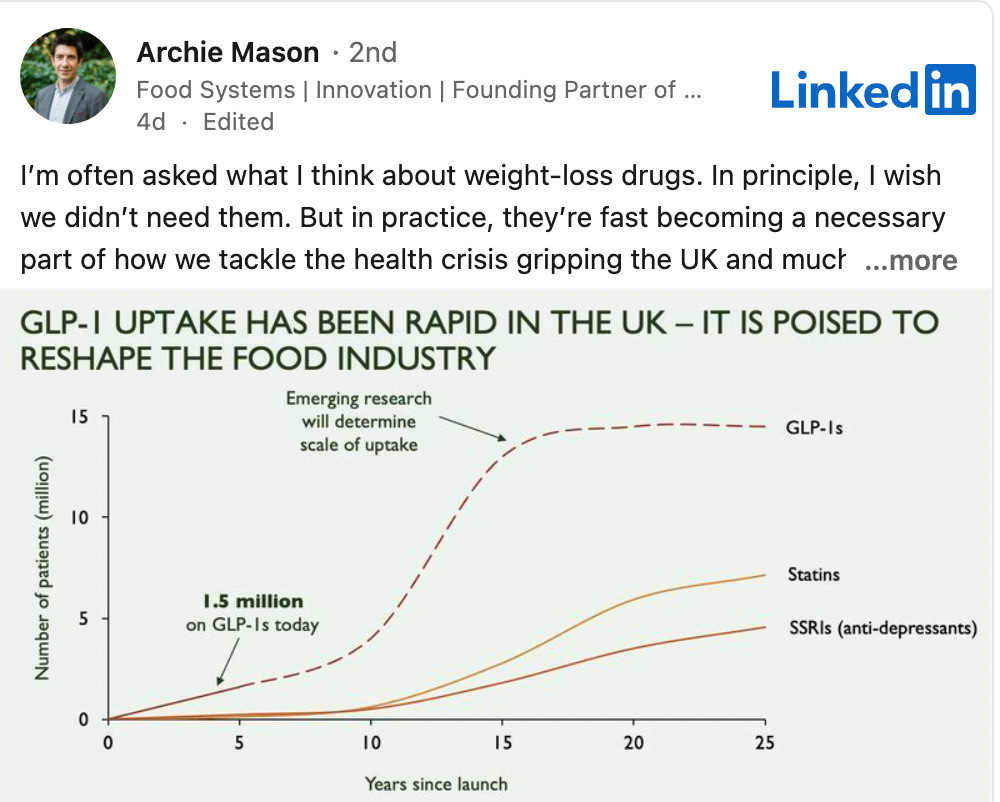GLP-1s, Health Equity, and the Problem with “Eating Less”
Health outcomes don’t improve with restriction alone. Here's why a balanced approach matters more than ever.
I was scrolling LinkedIn when I came across a post sharing the impact that weight-loss drugs, specifically glucagon-like peptide-1 (GLP-1) drugs, have on the food and beverage industry in the United Kingdom.
According to The Times, a decline in grocery sales in the UK has been attributed to the growing adoption of GLP-1s. Further, a recent Cornell SC Johnson College of Business Research Paper found an 8.6% decline in spending at fast-food chains, coffee shops, and limited-service restaurants. Let me be clear, some valid points are being made that should be considered as we’re seeing a more widespread adoption of GLP-1s.
While I agree with my colleagues that GLP-1 adoption is changing food demand, I’m skeptical that the demand to ‘eat less’ will improve health long-term without a balanced approach to nutrition.
By this, I mean having a foundation of nutrition rooted in what can be added to your diet, rather than what can be removed. For instance, when I started making profound dietary and lifestyle changes after my rheumatoid arthritis and Sjögren’s syndrome diagnosis, I did what most people did.
I took an ALL-OR-NOTHING approach, removing everything I deemed ‘unclean’ and replacing it only with what I considered ‘clean’ foods.
Did I benefit from letting go of my Starbucks Chai Tea Latte with five pumps of chai and Spicy Chorizo, Monterey Jack, and Egg Breakfast Sandwich? Considering that I’m lactose intolerant and now have an egg allergy, abso-freaking-lutely!
However, in my effort to only ‘eat clean,’ I didn’t consider that I was not only getting calories from these foods, but ‘energy’ from these foods. When I started feeling tired, hangry, and not a joy to be around, it became clear that my approach to nutrition was far from balanced. Yes, I was ‘eating healthier,’ but I wasn’t focused on consuming the right macronutrients, micronutrients, and phytonutrients that my body needed to get me through my day.
Here’s the thing:
We absolutely need macronutrients, as the proteins, carbohydrates, and fats we consume provide us with energy (which I was lacking) and the ability to build and repair our muscles.
However, we also need the vitamins and minerals in micronutrients to support everything, from cell growth to bone health.
Even though we dismiss phytonutrients like carotenoids, flavonoids, and glucosinolates, they help protect us against chronic diseases, reduce inflammation, and boost our immune system.
While the data might show that GLP-1s can be beneficial for changing food demand, we should not assume that their growing adoption is enough to create long-term health changes.
First, we must acknowledge that many in the UK and the US pay out of pocket for GLP-1s.
Second, we must remember that access will always be a challenge for those who cannot afford medications not covered by insurance.
Thirdly, and most importantly, a significant health literacy gap still impacts the general population's dietary choices.
Therefore, just because we’re seeing more consumers on GLP-1s eating less might not translate to them making balanced nutritional choices. I say ‘might’ because this isn’t a blanket statement for every GLP-1 user. Instead, it’s a suggestion that when we’re making (or are recommending) dietary changes, a balanced approach to nutrition is nonnegotiable.
Whether you’re on a GLP-1 or making dietary changes, avoid making the mistake I did. Ensure you start with a nutritional foundation so the results you’re obtaining aren’t just temporary but something you can maintain long-term.
Have you or someone you know been affected by the rising use of GLP-1s? What shifts have you noticed?



